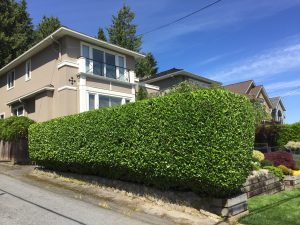Whether cedar, laurel, yew or boxwood hedge, these hedges can all be shaped into distinct styles. Formal, square hedges are commonly found on West Side properties. Recently, we have noticed a trend toward softer looking rounded corners. Rounded hedges are as tidy in appearance while providing another style option. Let’s look at the top shapes for hedges.

Formal hedge shape, straight sides and top with rounded corners
Formal Hedges: straight sides and straight, flat top. A Classic shape borrowed from formal French gardens. Straight sides with a rounded top is a softer variation of the squared off formal hedge.
Pyramidal sides can have either a straight, level top or rounded top edge as well. Also considered formal, the advantage of the pyramidal form is that it allows light to hit the bottom edge of the hedge. The narrower top prevents shading of the lower branches.
Informal hedges take on any shape, yet are easy to keep sheared and tidy. These may be wavy, or follow the natural curves of plants that have grown together over time.
Changing Shapes
In order to change the style of your hedge, please take note. Cedar can only be cut into its green growth, as they just hold 2-3 years worth of needles. This limits the extent to which the shape can be changed.
Yews, English laurel and boxwood will rejuvenate from old wood. Cut a laurel to the ground, and a new hedge will sprout from there. Keep in mind, it can take two to three years for a hedge to fill in after such a hard pruning.
Now you have creative license to get stylish with your hedges.
